Ultrasound Clinics: Mucocele of the appendix
ULTRASOUND CLINICS
Mucocele of the appendix
By Ana Monteagudo, MD, and Ilan E. Timor-Tritsch, MD
Despite the characteristic ultrasound image seen in this rare disease, appendiceal mucocele can easily be missed. Learning to accurately diagnose the disorder early on can sometimes mean the difference between life and death.
Unusual images can sometimes present a sonographer or sonologist with a knotty diagnostic dilemma. A rare condition known as cystadenoma or mucocele of the appendix is a case in point. It's important for gynecologists to recognize this entity for three reasons: (1) often they're the first ones to see an affected patient; (2) the condition has a malignant form, cystadenocarcinoma; and (3) mucocele of the appendix can be associated with pseudomyxoma peritoneia very serious entity.
Our goal here is to present the sonographic images of two affected patients, together with their clinical, intraoperative, and pathological findings. The good news is that any clinician who has been exposed to the typical sonographic image of a mucoceleeither in person or by viewing it in this articleshould be able to accurately make the diagnosis.
Case 1
A 35-year-old woman who had never been pregnant presented with sudden onset right lower quadrant pain, which had started 2 months earlier. The digital vaginal exam revealed a 10-cm left adnexal mass. Her history indicated kidney stones, spinal fusion, and laminectomy for a herniated disk. Transvaginal sonography (TVS) revealed a 10 x 3.5 x 3.5-cm tubular mass in the left adnexa with alternating circular hyper- and hypoechoic layers that gave it an "onion skin"-like appearance on the cross section view (Figure 1). Because it was located on the left side of the uterus, the clinician suspected some sort of bowel disorder with a differential diagnosis of a pyosalpinx. Free sliding of the structure was seen on TVS. Barium enema failed to fill the appendix and the CT scan showed an elongated pear-shaped cystic mass in a transverse portion crossing the midline (Figure 2).

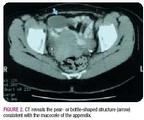
The patient underwent exploratory laparotomy, which revealed an enlarged and tubular appendix, which was removed (Figure 3). Pathological exam revealed extensive areas of adenomatous glandular tissue and slightly hyperplastic mucosa (Figure 4) with pigment-laden macrophages in the lamina propria, suggestive of melanosis coli (a black pigment that's infiltrated the colon wall). Although mucus had extruded into the appendiceal wall, no epithelial cells were seen in these areas. The final diagnosis: papillary cystadenoma of the appendix with mucocele.
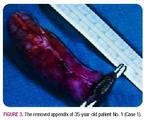

Case 2
A 45-year-old woman whose five pregnancies had resulted in three viable births and two abortions presented to a gynecologist for a second opinion on a right adnexal mass diagnosed by magnetic resonance imaging and ultrasound as a dilated fallopian tube. The MRI indicated bilateral hydrosalpinx. A CT scan was also performed and the structure on the right side was reported as an abscess.
TVS revealed an elongated "bottle-shaped" structure measuring 8.5 x 6 x 3.7 cm with an echogenic outer border and layered appearance (Figure 5). Alternating hyper- and hypoechoic layers were noted on the longitudinal (Figure 6) and cross sections, both of which clearly revealed the typical "onion skin"-like layered appearance. There were also circumscribed cystic areas that gave the image a "wavy" or "swirling" appearance. The U/S suggested mucocele of the appendix and laparoscopy revealed an enlarged appendix with thick walls and some fibrin deposits, which confirmed the diagnosis (Figure 7). After the appendix was removed, the pathological exam revealed a thick appendiceal wall with relatively flattened layers of glandular mucosa and a significant amount of amorphous mucus in the lumen (Figure 8).

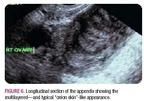
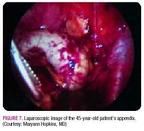
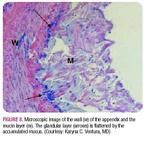
Interpreting U/S images of an appendiceal mucocele
Contrary to popular beliefand despite their large and heavy structureappendiceal mucoceles aren't necessarily restricted to the right side of the pelvisas was evident in Case 1. Usually located in the middle of the pelvis, they often present along the transverse axis of the pelvis.
On the longitudinal section, the lesion looks like a sausage-shaped elongated tubular structure. But it's also sometimes described as a bottle-shaped structure (in one of our two cases and in an additional case in the literature).1 On cross section, the lesion appears round. The outer border is hyperechoic while the lumen consists of concentric sheets of hyper- and hypoechoic rings. These rings are generated by the layered sediment of the mucinous material excreted by the glands of the appendiceal mucosa. In some cases, cystic or hyperechoic calcifications also appear in the wall and in the lumen of the organ. The layered circular appearance earned it the description of "onion skin"-like appearance. This image is pathognomonic and should be kept in mind whenever pelvic U/S scans are performed.
U/S outperforms MRI and CT. U/S should always be the "first line" diagnostic imaging method. In many cases ultrasonography (especially TVS) provides the most accuracy, even when compared to the concomitant use of MRI and CT scan.2 In both the cases presented here, MRI and CT scans were unable to provide the correct diagnosis. These two cases make it clear that despite the extremely typical sonographic picture of this pathologic disease, imaging modalities can easily miss it.
A relatively rare lesionas noted earliermucocele of the appendix is seen in about 0.25% of all appendectomies performed. The disease ranges from benign forms (inclusion cysts, hyperplasia of the glands, and cystadenomas) to the malignant cystadenocarcinoma.3,4 Benign forms are detected at an average age of 54, while adenocarcinomas are detected at an average age of 64.5
Detecting pseudomyxoma peritonei. In about 5% to 6% of cases of mucocele of the appendix, ascites is found with a gelatinous consistency. This is defined as pseudomyxoma peritonei, which represents a common way for cystadenocarcinomas to spread.1,4-8 Sonographically it can be detected as abdominal fluid with multiple loculations. Investigators reported on eight patients in whom pseudomyxoma peritonei was associated with benign cystadenomas (n=5) and cystadenocarcinomas (n=3) of the appendix.4 Paracentesis may reveal the diagnosis in these cases. The association of pseudomyxoma peritonei and cystadenocarcinoma decreases the survival rate of patients. Clearly then, it's very important to accurately diagnose appendiceal mucocele early on.
The larger mucoceles, due to their weight and thin attachment to the bowel, may undergo torsion, as shown by one team of researchers reporting on a pregnant woman at 38 postmenstrual weeks.9 A detailed discussion of the management of these patients is beyond the scope of this Ultrasound Clinic. But clearly, surgical intervention to remove the appendix is the first and important step in treatment. Early recognition may improve the outcome and minimize complications.
The pertinent literature suggests that the "banana-shaped" or "bottle-shaped" structure and layered "onion-skin" appearance are the pathognomonic hallmarks of the sonographic diagnosis. We believe that once sonographers become familiar with these U/S images, they will easily recognize mucocele of the appendix in the future.
REFERENCES
1. Degani S, Shapiro I, Leibovitz Z, et al. Sonographic appearance of appendiceal mucocele. Ultrasound Obstet Gynecol. 2002;19:99-101.
2. Kim SH, Lim HK, Lee WJ, et al. Mucocele of the appendix: ultrasonographic and CT findings. Abdom Imaging. 1998;23:292-296.
3. Woodruff R, McDonald JR. Benign and malignant cystic tumors of the appendix. Surg Gynecol Obstet. 1940;71:750-755.
4. Landen S, Bertrand C, Maddern GJ, et al. Appendiceal mucoceles and pseudomyxoma peritonei. Surg Gynecol Obstet. 1992;175:401-404.
5. Yeh HC, Shafir MK, Slater G, et al. Ultrasonography and computed tomography in pseudomyxoma peritonei. Radiology. 1984;153:507-510.
6. Fallon MJ, Low VH, Yu LL. Mucinous cystadenoma of the appendix with unusual sonographic appearances. Australas Radiol. 1994;38:339-341.
7. Fujiwara T, Hizuta A, Iwagaki H, et al. Appendiceal mucocele with concomitant colonic cancer. Report two cases. Dis Colon Rectum. 1996;39:232-236.
8. Nakao A, Sato S, Nakashima A, et al. Appendiceal mucocele of mucinous cystadenocarcinoma with a cutaneous fistula. J Int Med Res. 2002;30:452-456.
9. Abu Zidan FM, al-Hilaly MA, al-Atrabi N. Torsion of a mucocele of the appendix in a pregnant woman. Acta Obstet Gynecol Scand. 1992;71:140-142.
Dr. Monteagudo is Associate Professor of Obstetrics and Gynecology and Associate Director of the NYU Obstetrical and Gynecological Ultrasound Unit, New York, N.Y., and Dr. Timor-Tritsch is Professor of Obstetrics and Gynecology at NYU School of Medicine and Director of the NYU Obstetrical and Gynecological Ultrasound Unit, New York, N.Y.
Department editors are Dr. Timor-Tritsch and Joshua A. Copel, MD, Professor, Department of Obstetrics and Gynecology, Section Head, Maternal-Fetal Medicine, and Director of Obstetrics, Yale-New Haven Hospital, New Haven, Conn.
Ana Monteagudo, Illan Timor-Tritsch. Ultrasound Clinics: Mucocele of the appendix. Contemporary Ob/Gyn Oct. 1, 2003;48:62-68.
Self-diagnosing vaginismus found accurate vs health care provider diagnosis
October 15th 2024In a recent study presented at the 25th Annual Fall Scientific Meeting of SMSNA, similar diagnosing success was reported between self-diagnosis and diagnosis from a health care provider for vaginismus.
Read More
Study: Pelvic floor dilator reduces pelvic floor muscle injury during vaginal delivery
August 6th 2024A new pilot study published in the International Urogynecology Journal found that Materna Medical’s Prep Device, a pelvic floor dilator, reduced full levator ani muscle avulsion during vaginal delivery in first-time mothers.
Read More
